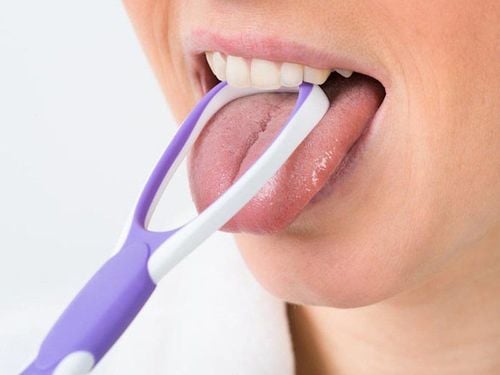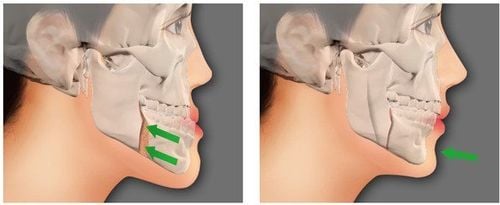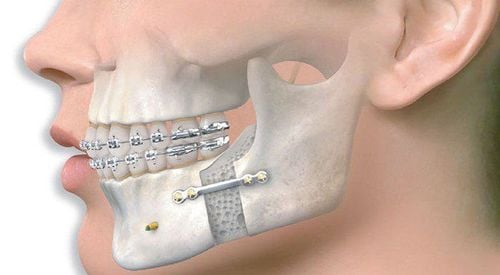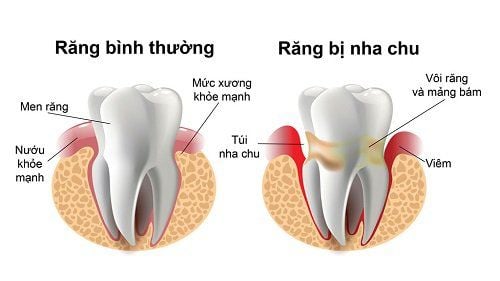This is an automatically translated article.
Article written by MSc Lai Do Quyen - Doctor of Dental - Jaw - Facial - Interspecialty Department - Vinmec Times City International Hospital
Making a bridge is a method of making fixed dentures to compensate for lost teeth, restore the ability to chew, ensure the aesthetics as well as other functions of the teeth. There are many types of materials for making dental bridges. Currently, making porcelain bridges is quite a choice of many people because of their beautiful teeth. But are porcelain bridges really good, who can make porcelain bridges is still a question of many of you. In this article, we will share with you about porcelain bridges, helping you make the right choice when considering replacing your missing tooth.
1. What is a porcelain bridge?
Porcelain bridge is a popular solution to restore one or more fixed missing teeth today. Just like you cross a bridge over a river, a bridge consists of 2 or more abutments which are the teeth on the jaw or implant posts and the span is one or more missing teeth. The abutments are the fulcrums that carry the missing teeth. The bridge is fixed on the abutment teeth, thereby, helping to fill the missing tooth space on the jaw arch.
Porcelain bridge is a bridge made of porcelain material.
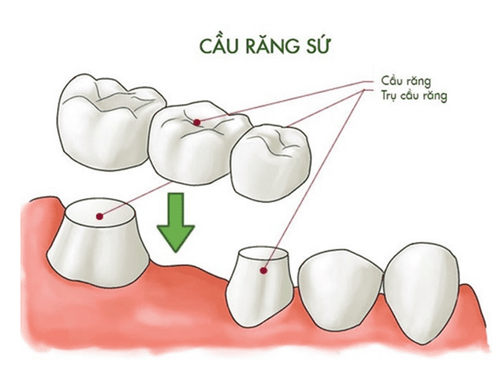
2. Types of porcelain dental bridges
2.1. Traditional porcelain bridge
Traditional porcelain bridges are quite popular. Abutment teeth are the healthy teeth on either side of the missing tooth space. The dentist will grind down the teeth as pillars to create enough space for a crown (like a hat) to cover the abutment teeth, between the abutment teeth will be a band of porcelain teeth attached to the crowns facing down on the abutment teeth. to replace lost teeth.
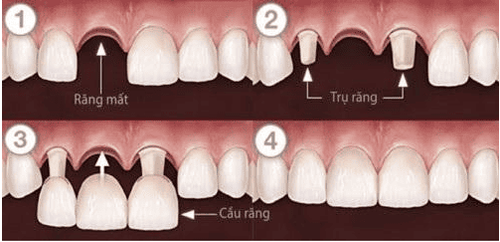
2.2. Porcelain dental bridge with (Pass porcelain tooth bridge)
With this type of bridge, the dentist will use one or two abutment teeth in front or behind the missing tooth to make a bridge. However, this bridge is not recommended to be done widely because it is easy to affect the abutment teeth if the chewing force is not good.
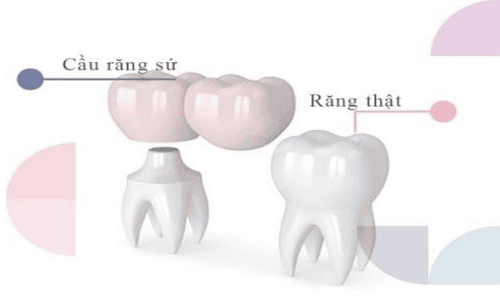
2.3. Porcelain dental bridge with glued wings
Is a type of bridge that has the ability to preserve the maximum abutment teeth due to less tooth grinding. The bridge consists of a porcelain denture with two wings glued on both sides. In which, dentures will fill in the space of the missing teeth and the two glued wings will be fixed on the inside of the two abutment teeth on either side of the missing tooth. Flanges can be made of porcelain or metal. However, this type of bridge is weak, has poor chewing force, and is easy to fall, so it should only be done in the front teeth with careful consideration of the dentist.
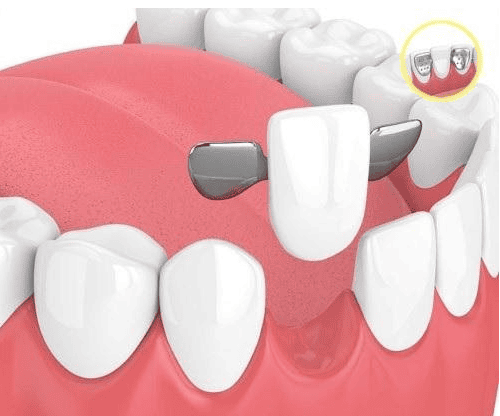
2.4. Porcelain bridge on Implant post
The abutment teeth of this type of bridge are not real teeth but implant posts that are implanted in your jawbone. This bridge does not affect or damage the natural teeth next to the lost teeth because real teeth are not used as a fulcrum, creating an appropriate distance between the teeth to help the bridge be stable and the jawbone at about Less lost teeth.
>>> What to do after Implant?
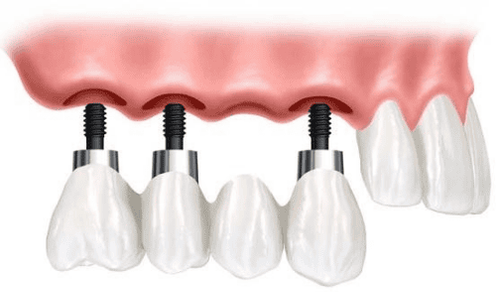
3. Pros and cons of porcelain bridges
3.3. Advantage
Fast implementation time, helping to restore lost teeth within 4-5 days compared to the way of replacing lost teeth with implant posts. The bridge will be fixed to the abutment teeth on the jaw, so it will create a natural chewing feeling like real teeth. Porcelain bridges have hardness, firmness, and good chewing ability compared to real teeth. Porcelain bridges have high aesthetics, natural tooth color, matching the real teeth on the jaw arch. Does not cause irritation to the tissues in the oral cavity. If the bridge is made of non-metallic ceramic material, it will avoid the phenomenon of "image noise" when taking X-ray film, tomography film (CT-scanner) or magnetic resonance imaging (MRI) going through the affected area. tooth bridge. Restoring other functions of the teeth such as: + Restore the bite to normal
+ Restore the ability to pronounce, communicate more clearly
+ Maintain the natural face shape.
Prevent or eliminate other disadvantages caused by tooth loss such as: + Preventing the situation of the teeth above and on either side of the missing teeth moving when the jaw arch has gaps.
+ Prevents the pathology of the temporomandibular joint caused by tooth loss.
The use time of a porcelain bridge is also quite long if the bridge is properly cared for and protected.
3.2. Defect
The real teeth used as pillars to carry the missing teeth will be grinded down in the bridge making technique, leading to the abutment teeth that may be sensitive or affect the tooth pulp later. Abutment teeth may have to be modified such as root canal treatment, lowering,... to fit the requirements of an abutment tooth. Choosing teeth as abutment also requires very strict requirements on the quality of abutment teeth as well as respecting the principle of force for bridges. Thus, not all cases of missing teeth can be made with porcelain bridges. If the tooth gap is too long, the missing teeth have the main chewing role, then a porcelain bridge is not a perfect choice. Making a porcelain bridge can only replace the upper part of the tooth, not the root. Therefore, this method does not completely prevent jaw bone loss and shrinking gums due to tooth loss. Over time, the bridge will lose its aesthetic appeal. The loss of jaw bone, receding gums in the position of missing teeth also affects the abutment teeth and makes the abutment teeth weaker if the jaw bone is too much resorbed, causing the root of the abutment teeth to open. Cleaning under bridges is more difficult than cleaning real teeth. If the bridge is not cleaned well, it will lead to bad breath, inflammation of the gums due to the accumulation of food under the bridge. The abutment teeth may be damaged, at that time the entire abutment tooth must be removed and a new porcelain bridge must be made.

4. Is porcelain dental bridge good?
With the disadvantages of a porcelain bridge mentioned above, it will make you shy and maybe nervous when deciding to make a porcelain bridge. However, if the abutment teeth are selected correctly, the tooth loss is not too long, the dentist respects the principle of chewing force for the bridge, the technical requirements are guaranteed, the bridge is preserved and well kept. If the bridge and teeth are regularly cleaned, a porcelain bridge is a suitable option even perfect if the missing teeth cannot be replaced by implantation.
5. Who can make porcelain bridges?
The method of making a bridge to replace lost teeth has been used by dentists for a long time, before the implantation technique. Currently, with the development of the dental materials industry, many types of porcelain materials have been created with properties similar to real teeth, both able to withstand chewing force and ensure aesthetics, so porcelain bridges are widely used to compensate. missing teeth in the following cases:
Loss of one or two consecutive molars. The missing teeth alternate. Missing one or more front teeth. Making bridges on implant posts. Besides assessing the specific state of tooth loss, the dentist must also rely on other factors to decide whether a porcelain bridge is the best solution for you, such as: The pier must be strong and firm. The gums around the abutment teeth are not inflamed. The gums in the area of tooth loss must be firm. The teeth in the opposite jaw are in good condition. The implant posts are firmly attached to the jawbone and carefully calculated to carry the bridge. Good oral hygiene condition. Systemic condition is healthy or systemic disease has been treated stably.
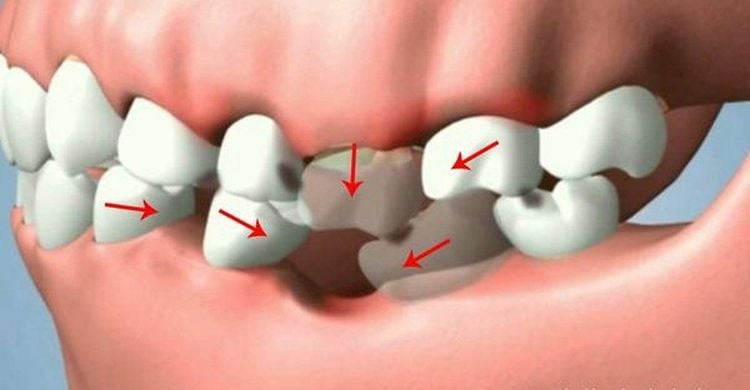
6. How to make a porcelain dental bridge last long in the mouth?
Whether a porcelain bridge can be used for a long time in the mouth depends on many factors:
Chewing habits: + If you have a habit of bringing your jaw to the sides to grind food, then in addition to the vertical chewing force, the teeth will will have to bear more bending force due to the tooth being rotated, over time the abutment teeth will lose the bone holding the tooth root. At that time, you will see the gums around the abutment teeth recede, the abutment teeth are painful or wobbly. At this time, it is possible that the abutment tooth will not be strong enough to carry a bridge, the tooth must be removed and a new bridge must be made to replace the missing tooth.
+ If you only chew on one side, it is also a habit that causes rapid damage to the bridge on the side you chew because the abutment teeth are often subjected to a chewing force that is too strong for them to bear. As a result, the abutment teeth will quickly recede, lose bone and be damaged.
+ The habit of using the front teeth to bite or nag food also makes the bridge in this area easy to break and break.
Habit of moving jaws: if you have a habit of sliding the lower front teeth forward, the bridges on the incisors side will be affected by the push in the direction of the jaw sliding, making the abutment teeth also affected. Thus, the bridge will not be durable. Habits of using food: hard, chewy foods are easy to break, and the porcelain of the bridge is chipped. How to clean your teeth: brush your teeth after eating, clean the food in between the teeth around the bridge with floss, remove the food under the bridges with a thread or a water flosser. Brush properly to avoid receding gums and neck wear in the abutment teeth. Real tooth tissue: if the teeth that make the abutment are deeply decayed or broken, there is very little remaining tooth tissue, then they themselves will be very weak. At that time, the dentist will reinforce the tooth pin or a prosthesis before making a crown to wear the bridge. In such a case, your dentist will thoroughly discuss your treatment plan and care plan to try to make the bridge last as long as possible. Dental skills: choosing a good dentist with experience in prosthetics will be an advantage, helping you to use porcelain bridges for a long time. + Teeth grinding technique must be performed by a highly qualified dentist, doing the right technique and grinding teeth at the right rate, it will not be dangerous to the teeth as a pillar or the health of the body. On the contrary, if the dentist performs this operation incorrectly and incorrectly, the harm of tooth grinding is very great. Teeth can be severely sensitive, the real tooth organization is lost a lot leading to damage, the pulp is damaged and worse, the tooth is lost.
+ The technique of fitting porcelain teeth is also very important. A porcelain bridge before being attached to the tooth must be carefully checked by the dentist for the tight fit of the crowns to the abutment teeth, for the close contact with the surrounding real teeth. If the porcelain bridge is unsatisfactory, not tight, but still attached to the abutment teeth, it will cause food to accumulate in the open place, causing bad breath, over time, the abutment tooth will be decayed, broken, and may not be kept. get teeth.
Making a porcelain bridge to replace lost teeth is a good option. If the dentist and you both comply well with the technical requirements, preservation and use of the bridge, a porcelain bridge can be used for a long time to meet the requirements to ensure chewing function, aesthetic function. aesthetics and other functions of teeth.
Vinmec Times City International General Hospital gathers a team of dentists with nearly 30 years of clinical experience, formally trained in prosthetics, who will work with you to choose the right solution for making porcelain bridges to restore your teeth. Restore lost teeth, helping you regain comfort, confidence and shine.
Please dial HOTLINE for more information or register for an appointment HERE. Download MyVinmec app to make appointments faster and to manage your bookings easily.





